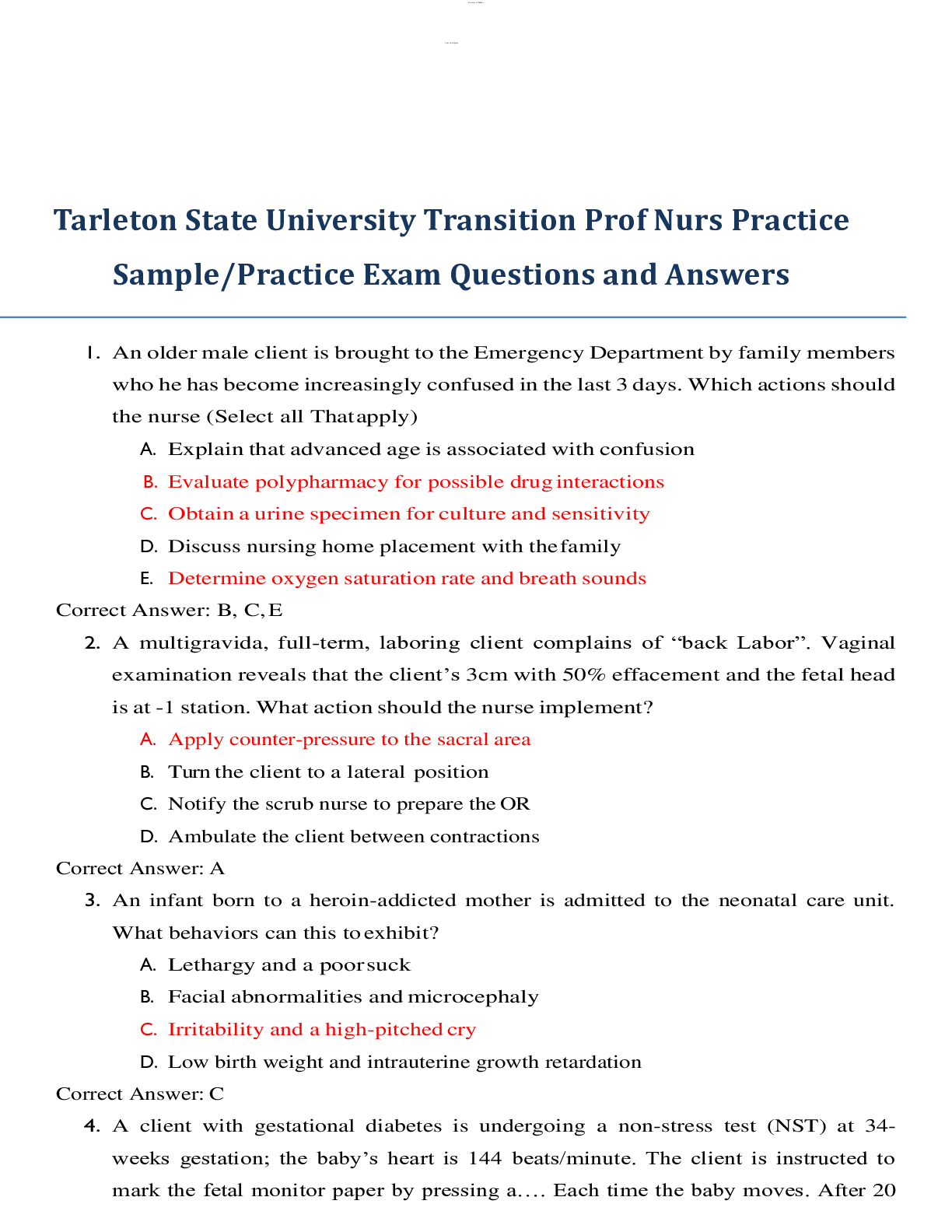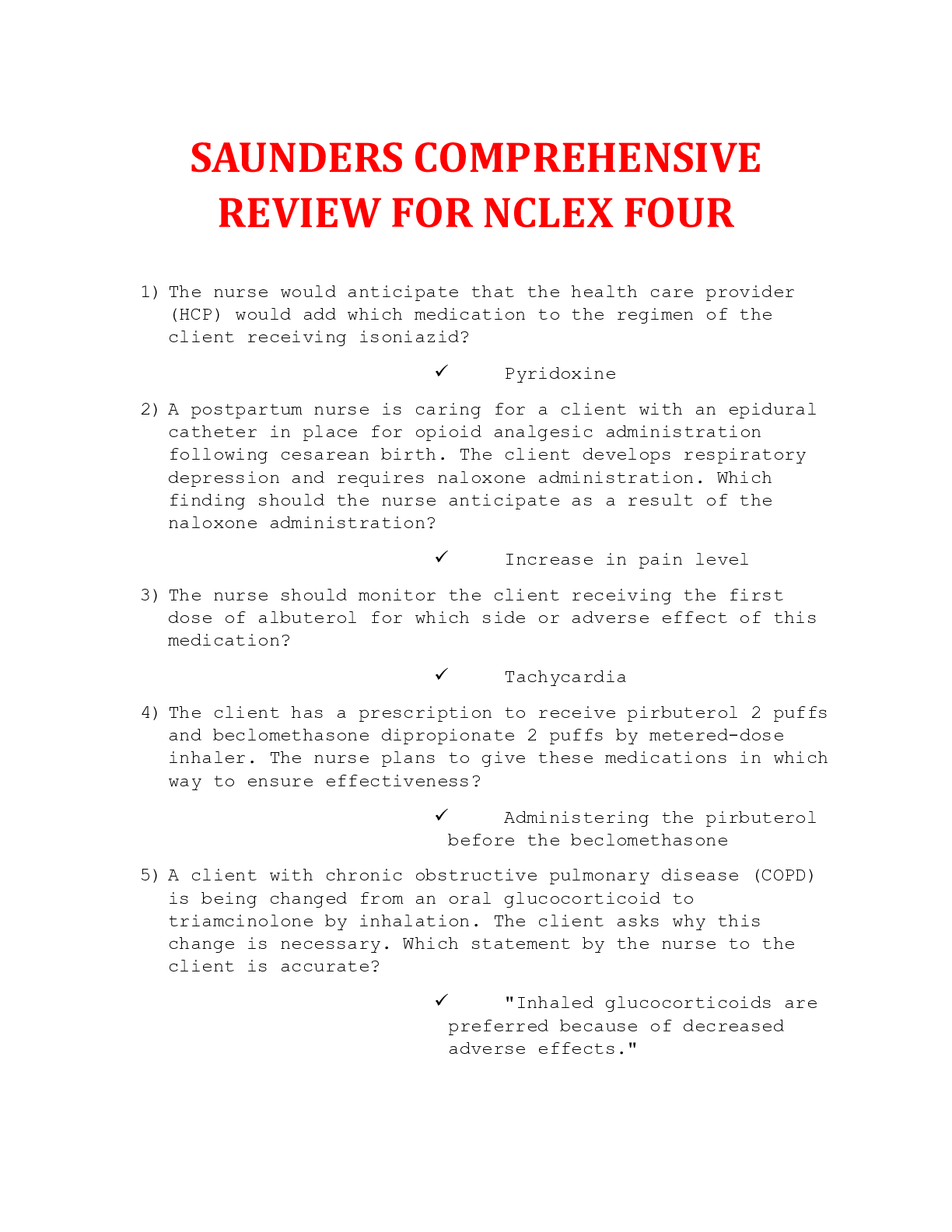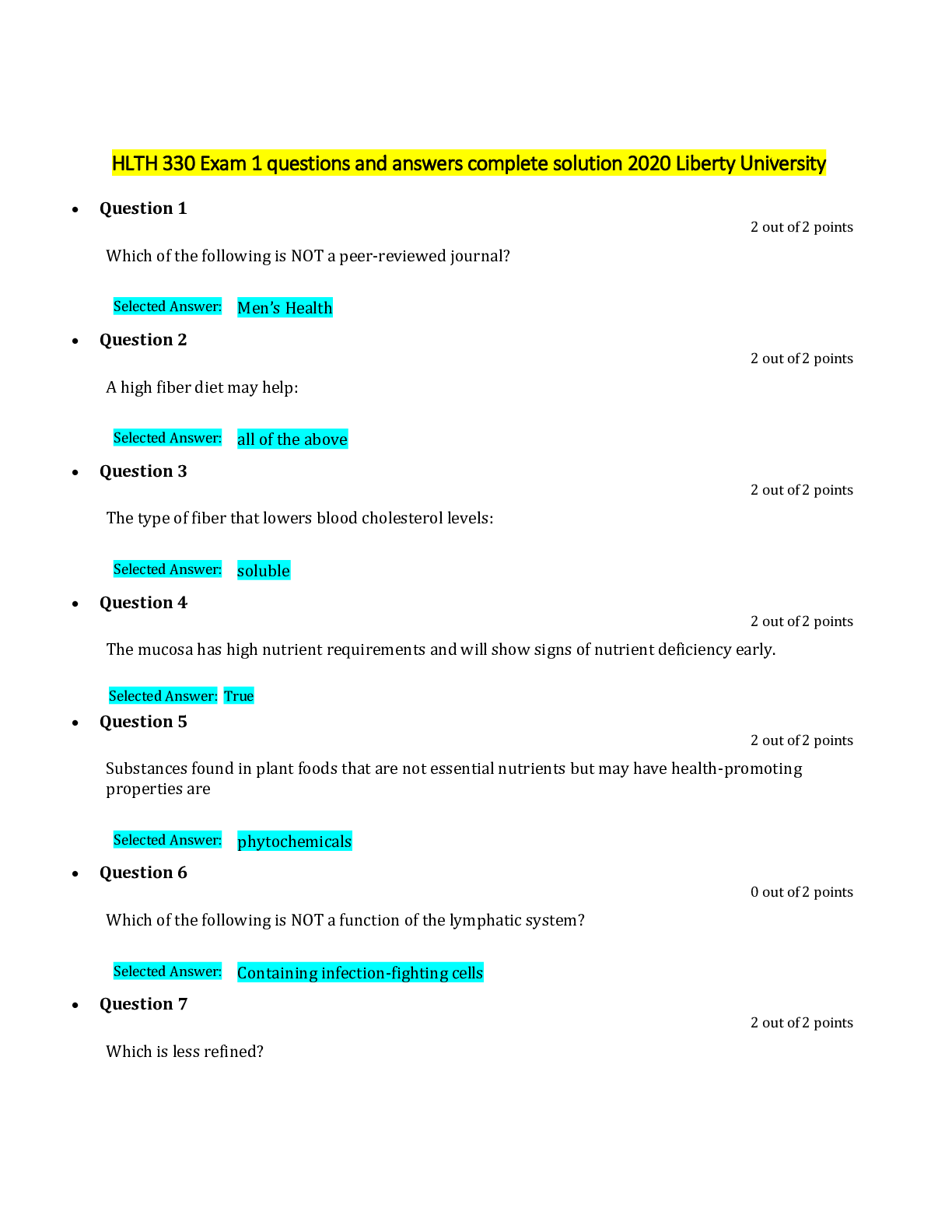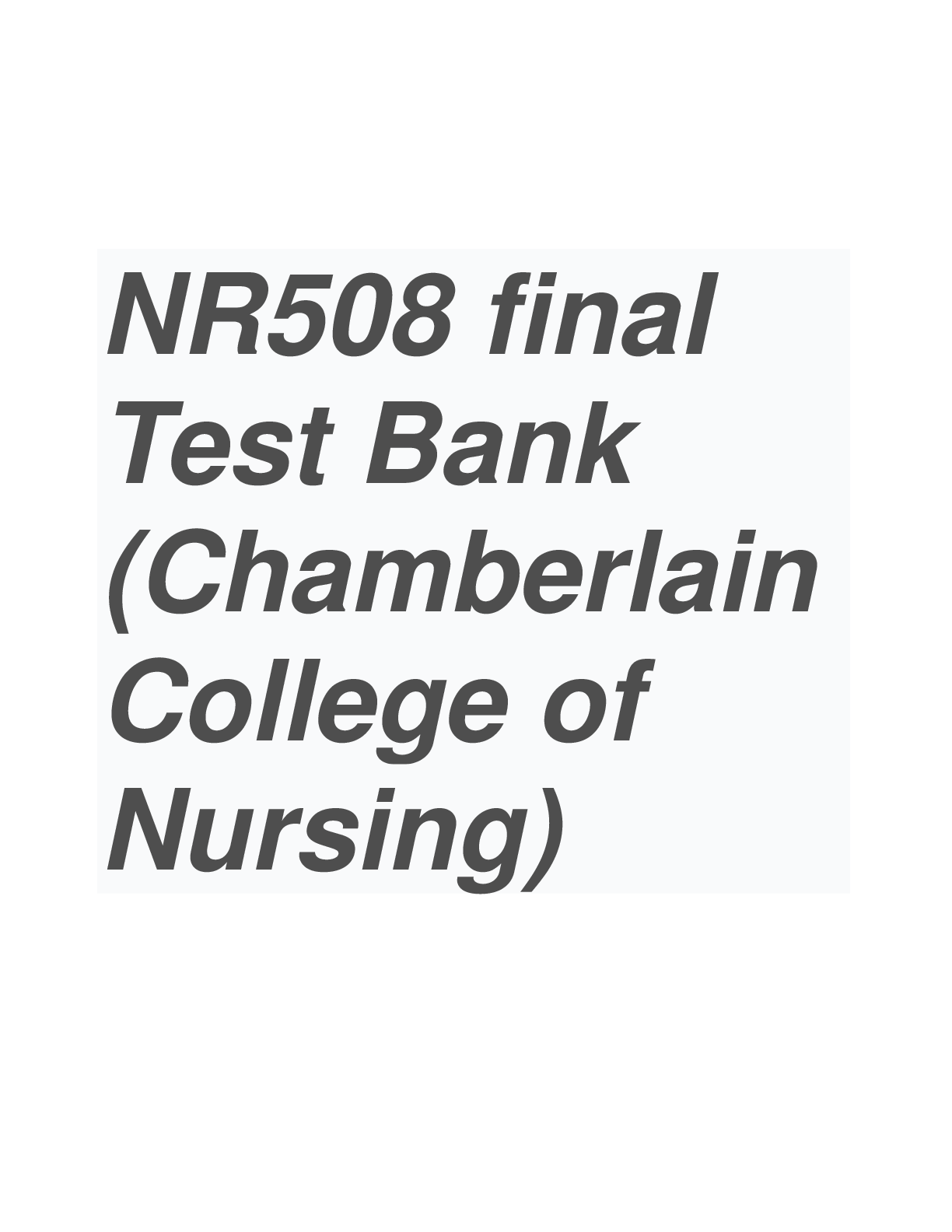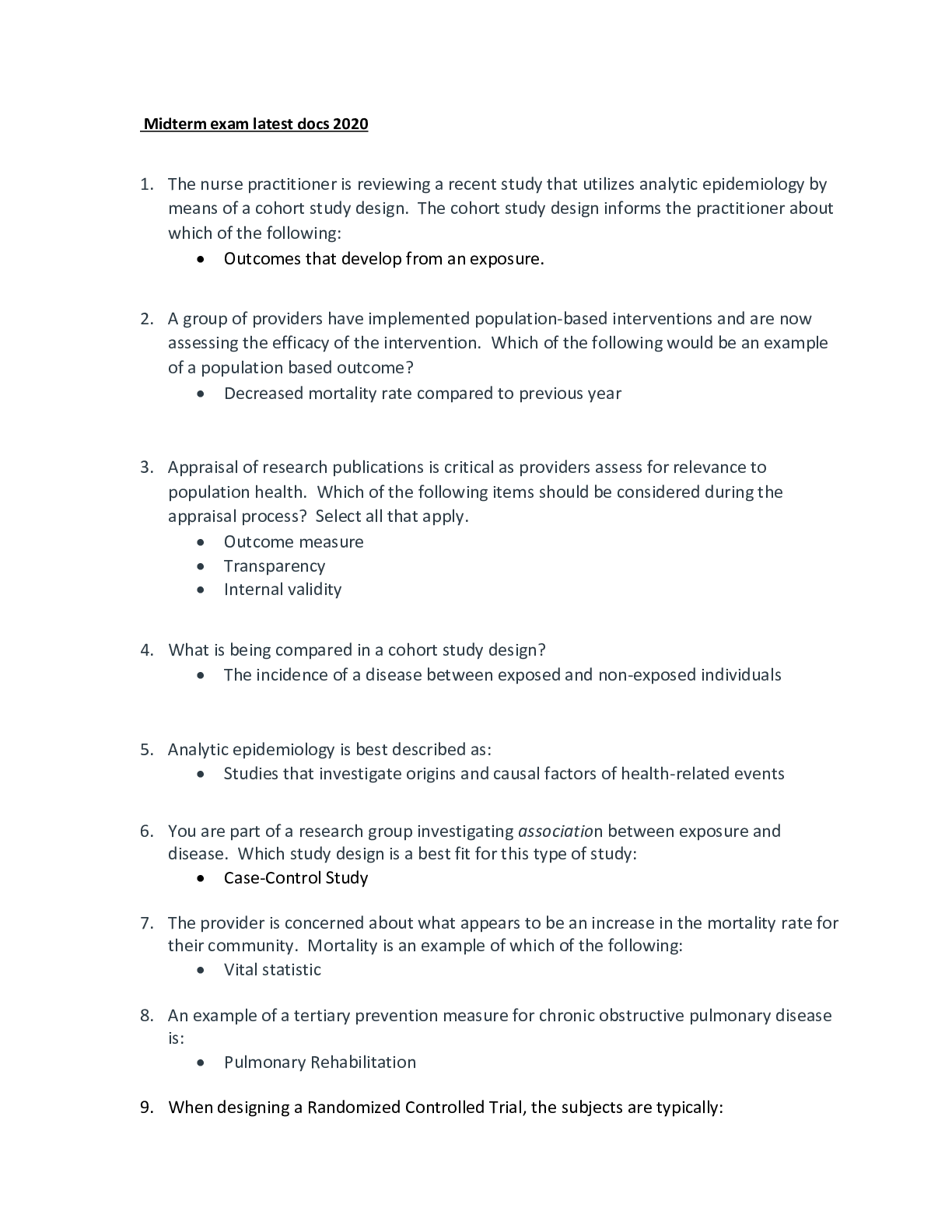Health Care > QUESTIONS & ANSWERS > ATI Community Health Nursing: Chapter 1 Questions and Answers Graded A (All)
ATI Community Health Nursing: Chapter 1 Questions and Answers Graded A
Document Content and Description Below
ATI Community Health Nursing: Chapter 1 Questions and Answers Graded A Nursing theories provide ✔✔the basis for care of the community and family Nurses working in the community should have an u... nderstanding of ✔✔the foundations of community health nursing, the principles of community health nursing, and health promotion and disease prevention Nightingale's Theory of Environment ✔✔Highlights the relationship b/w and individual's environment and health; depicts health as a continuum; emphasizes PREVENTIVE care. Health Belief Model -- Purpose ✔✔to predict or explain health behaviors; assumes that preventive health behaviors are taken primarily for the purpose of avoiding disease;emphasizes change at the INDIVIDUAL level Health Belief Model -- Describes the likelihood of taking an action to avoid disease based on: ✔✔perceived susceptibility, seriousness, and threat of a disease; modifying factors; cues to action; perceived benefits minus perceived barriers to taking action Milio's Framework for Prevention ✔✔complements the health belief model; emphasizes change at the COMMUNITY level; ID's relationship b/w health deficits and availability of healthpromoting resources; theorizes that behavior changes within a large number of people can ultimately lead to social change Community ✔✔a group of people and institutions that share geographic, civiv, and/or social parameters A community's health is determined by ✔✔the degree to which the community's collective health needs are ID'd and met Health indicators ✔✔mortality rate, disease prevalence, levels of physical activity, obesity, tobacco use, and substance use Population ✔✔an aggregate who shares one or more personal characteristics Who is the client in community health nursing? ✔✔Community or Population Community-Based Nursing ✔✔Focuses on: Individuals and Families Activities: ILLNESS CARE -- management of acute or chronic conditions in settings where individuals, families, and groups live, work, and "attend" Ex) Home health nursing, school nurse, employee health, student health, camp nurse, prison clinic Community-Oriented Nursing ✔✔Focuses on: AT-RISK individuals, families, and groups + the community Activities: HEALTH CARE -- determining health needs of the community, and intervening at the individual, family, and group level to improve the collective health of the community Community Health Nursing Practice ✔✔Focuses on: synthesis of nursing and public health theory Activities: DOING -- promote, preserve, and maintain the health of a population by DELIVERY of health services to individuals, families, and groups in order to impact "community health" Public Health Nursing Practice ✔✔Focuses on: Synthesis of nursing and public health theory Activities: PREVENTING -- promote, preserve, and maintain health through disease and disability PREVENTION and health protection of community as a whole Public Health Nursing Core Functions: ✔✔1. Systematic assessment of the health of a population 2. Development of policies to support the health of populations 3. Ensuring that essential health services are available to all persons Ethical Considerations ✔✔Preventing harm, doing no harm, promoting good, respecting both individual and community rights, respecting autonomy and diversity, and providing confidentiality, competency, trustworthiness, and advocacy. CH Nurses are concerned with: ✔✔protecting, promoting, preserving, and maintaining health; as well as preventing disease Client rights include: ✔✔the right to information disclosure, privacy, informed consent, information confidentiality, and participating in treatment decisions Respect for AUTONOMY ✔✔Definition: individuals select those actions that fulfill their goals Situation: respecting a client's right to self-determination (ex: making the decision to no pursue chemotherapy) NONMALIFICENCE ✔✔Definition: no harm is done when applying standards of care Situation: developing plans of care that include a system for monitoring and evaluating outcomes BENEFICENCE ✔✔Definition: max. possible benefits and min. possible harms Situation: assessing risks and benefits when planning interventions DISTRIBUTIVE JUSTICE ✔✔Definition: fair distribution of the benefits and burden in society is based on the needs and contributions of its members Situation: determining eligibility for health care services based on income and fiscal resource Advocacy roles of the nurse ✔✔informer, supporter, and mediator (pg. 5) Epidemiology ✔✔the study of health-related trends populations for the purpose of disease prevention, health maintenance, and health protection; relies on stat. evidence to determine rate of spread of disease and the promotion of people affected Epidemiology provides a broad understanding of: ✔✔spread, transmission, and induce of disease and injury Epidemiology triangle ✔✔relationship among an agent, a post, and an environment; their interaction determines the development and cessation of communicable diseases The AGENT ✔✔is the animate or inanimate object that causes the disease The HOST ✔✔is the living being that is affected by the agent The ENVIRONMENT ✔✔is the setting or surrounding that sustains the host INCIDENCE ✔✔number of cases in the population at a specific time DIVIDED BY population total TIMES 1,000 = __________ per 1,000 PREVELANCE ✔✔number of existing cases in the population at a specific time DIVIDED BY population total TIMES 1,000 = ________ per 1,000 CRUDE MORTALITY RATE ✔✔number of deaths DIVIDED BY population total TIMES 1,000 = ______ per 1,000 INFANT MORATALITY RATE ✔✔number of infant deaths before 1 year of age in a year DIVIDED BY number of live births in the same year TIMES 1,000 = _______ per 1,000 ATTACK RATE ✔✔number of people exposed to a specific agent who develop the disease DIVIDED BY total number of people exposed An epidemic is: ✔✔when the rate of disease exceeds the usual level of the condition in a defined population A pandemic is: ✔✔is an epidemic of infectious disease that has spread through human populations across a large region; for instance multiple continents, or even worldwide. An endemic is: ✔✔disease or condition regularly found among particular people or in a certain area; i.e. Malaria Principles of Public Heath Nursing ✔✔Focus on community. Give priority to community needs. Work in partnership with the people. Focus on primary prevention. Promote a healthful environment. Target all who might benefit. Promote optimum allocation of resources. Collaborate with others in the community. Community orientation: ✔✔process actively shaped by the unique experiences, knowledge, concerns, values, beliefs, and culture of a given community Population focus: ✔✔use of population-based skills such as epidemiology, research in community assessment, and community organizing as the basis for interventions Relationship-based care: ✔✔reciprocal, caring relationship with the community; listening , participatory dialogue, and critical reflection Roles in Community Health Nursing: ✔✔CLINICIAN: care provider; holism, health promotion, and prevention EDUCATOR: health teacher ADVOCATE: on behalf of the client; supporter MANAGER: participative approach with community COLLABORATOR: working with others LEADER RESEARCHER: investigate and collect; EBP to community setting National health goals guide the nurse in ✔✔developing health promotion strategies to improve individual and community health Screening programs ✔✔the responsibility of the CHN; provide accurate, reliable results, can be inexpensively and quickly administered to large groups, and produce few if any side effects Primary Prevention ✔✔prevention of the initial occurrence of disease of injury Primary Prevention examples: ✔✔education prenatal classes providing immunizations advocate for access to health care, healthy environments Secondary Prevention ✔✔early detection and treatment of disease with the goal of limiting severity and adverse effects Secondary Prevention examples: ✔✔community assessments, disease surveillance, screenings, control of outbreaks communicable dieases Tertiary Prevention ✔✔maximization of recovery after an injury or illness (rehabilitation) Tertiary Prevention examples: ✔✔Nutrition counseling, exercise rehabilitation, care management, PT, OT, support groups, and exercise for HTN clients [Show More]
Last updated: 1 year ago
Preview 1 out of 10 pages
Instant download
.png)
Buy this document to get the full access instantly
Instant Download Access after purchase
Add to cartInstant download
Also available in bundle (1)
.png)
ATI COMMUNITY HEALTH BUNDLED EXAMS QUESTIONS AND ANSWERS RATED A
ATI COMMUNITY HEALTH BUNDLED EXAMS QUESTIONS AND ANSWERS RATED A
By Nutmegs 1 year ago
$16
7
Reviews( 0 )
Document information
Connected school, study & course
About the document
Uploaded On
Jan 19, 2023
Number of pages
10
Written in
Additional information
This document has been written for:
Uploaded
Jan 19, 2023
Downloads
0
Views
150

.png)
.png)
.png)
.png)
.png)
.png)
.png)
.png)
.png)
.png)
.png)



